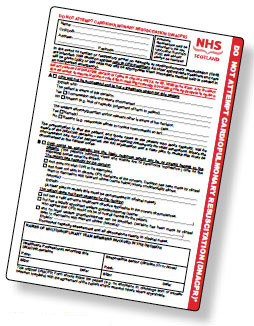Cardiopulmonary resuscitation decisions - integrated adult policy: guidance
Updated guidance on cardiopulmonary resuscitation (CPR) policy reflecting feedback and changes to national good practice.
The DNACPR Form

The DNACPR form in itself is not legally binding. It should be regarded as evidence that an advance clinical assessment and decision has been made and recorded to guide immediate clinical decision-making for those who may encounter the patient in the event of a cardiopulmonary arrest or expected death. When a DNACPR form is completed it is essential that the decision-making process and any relevant discussions and conversations are documented clearly and fully in the clinical notes. Where conversations with the patient and/or their relevant others have not taken place, the reasons for this must be clearly documented in the clinical notes with a plan to review this.
A clinical team that knows the patient and is certain of the background to the decision should not regard the decision as invalid simply because a form has been incorrectly completed. If the patient is not known, and an incorrectly completed form is present, advice should be sought from other sources (e.g. KIS, or the contact details on the form).
The presence or absence of a DNACPR form should not override clinical judgement about what will be of overall benefit to the patient in an emergency (e.g. choking, anaphylaxis, sepsis etc.).
Where CPR will not work or is not wanted a DNACPR form should be completed following the appropriate communication with the patient or relevant others, and the decision communicated to those involved in the patient's care. It is important that all relevant healthcare and social care professionals involved in the patient's care are aware that a decision not to give CPR has been made and documented on a DNACPR form. In order to facilitate rapid communication of the decision in an emergency, the original DNACPR form should be immediately accessible wherever the patient is being cared for.
When a patient is moving to a different care setting, a photocopy of the original form may be retained for medical record audit purposes. A line should be drawn through the photocopy to make it clear that it is not the valid DNACPR form, before it is filed in the records. The original form should go with the patient.
When a patient is at home, they and/or their relevant others must have been made aware of the DNACPR form for it to be of use in an emergency situation. Where this information has not been given due to the likelihood of this causing physical or psychological harm to the patient, the form must not be sent home with the patient. The patient's GP should be supported to record the advance decision that CPR is not a treatment option within the electronic KIS record with an explanation of the patient and family's understanding.
When a patient is being transferred to a different care setting, it is necessary for the ambulance crew involved to have the original DNACPR form, or have verbal/electronic confirmation that the DNACPR form exists. The crew must also be informed of whether there has been discussion with the patient and family about the DNACPR form prior to the journey. This ensures compliance with the Scottish Ambulance Service End-of-Life Care Policy (2014). It is important that a preferred destination and point of contact is documented on the form in case the patient should die whilst in transit. If there is no destination documented the ambulance crew will take the patient's body to the nearest A&E department or as otherwise advised by their clinical advisor.
The Out of Hours Service must be made aware of the existence of the DNACPR form using the KIS when the patient is being cared for in the community. When a DNACPR decision is reversed, the KIS record must be updated as soon as is reasonably possible.
When a DNACPR decision is being reversed, this must be signed and dated in the review box but the form should also be clearly scored through with a black pen and the word "REVERSED" written across it. The invalid form should then be filed in the back of the clinical notes. Where paper-light/electronic systems are in use, Boards must ensure there is a consistent and robust way of communicating the DNACPR decision and clearly show where it has been reviewed and/or reversed.
There will be exceptional situations where a patient for whom CPR would clearly not work is being discharged home without a DNACPR form because the conversation would cause harm. It is essential that this information is promptly and effectively communicated to the patient's GP so that their KIS can be updated to reflect this situation. DNACPR guidance within the KIS or provided verbally by a clinician who knows the patient (e.g. GP or district nurse) should be acknowledged and acted on appropriately when a DNACPR form is not available in the emergency situation.
Contact
Email: Elizabeth Gourlay, elizabeth.gourlay@gov.scot
There is a problem
Thanks for your feedback